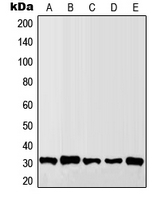Anti-Granzyme B/H Antibody
- SPECIFICATION
- CITATIONS
- PROTOCOLS
- BACKGROUND

Application
| WB, IHC |
|---|---|
| Primary Accession | P10144 |
| Other Accession | P20718 |
| Reactivity | Human, Mouse, Rat |
| Host | Rabbit |
| Clonality | Polyclonal |
| Calculated MW | 27716 Da |
| Gene ID | 3002 |
|---|---|
| Other Names | GZMB; CGL1; CSPB; CTLA1; GRB; Granzyme B; C11; CTLA-1; Cathepsin G-like 1; CTSGL1; Cytotoxic T-lymphocyte proteinase 2; Lymphocyte protease; Fragmentin-2; Granzyme-2; Human lymphocyte protein; HLP; SECT; T-cell serine protease 1-3E; GZMH; CGL2; CTSGL2; Granzyme H; CCP-X; Cathepsin G-like 2; CTSGL2; Cytotoxic T-lymphocyte proteinase; Cytotoxic serine protease C; CSP-C |
| Target/Specificity | KLH-conjugated synthetic peptide encompassing a sequence within the N-term region of human Granzyme B/H. The exact sequence is proprietary. |
| Dilution | WB~~1/500 - 1/1000 IHC~~1:100~500 |
| Format | Liquid in 0.42% Potassium phosphate, 0.87% Sodium chloride, pH 7.3, 30% glycerol, and 0.09% (W/V) sodium azide. |
| Storage | Store at -20 °C.Stable for 12 months from date of receipt |
| Name | GZMB {ECO:0000303|PubMed:32188940, ECO:0000312|HGNC:HGNC:4709} |
|---|---|
| Function | Abundant protease in the cytosolic granules of cytotoxic T- cells and NK-cells which activates caspase-independent pyroptosis when delivered into the target cell through the immunological synapse (PubMed:1985927, PubMed:3262682, PubMed:3263427). It cleaves after Asp (PubMed:1985927, PubMed:8258716). Once delivered into the target cell, acts by catalyzing cleavage of gasdermin-E (GSDME), releasing the pore- forming moiety of GSDME, thereby triggering pyroptosis and target cell death (PubMed:31953257, PubMed:32188940). Seems to be linked to an activation cascade of caspases (aspartate-specific cysteine proteases) responsible for apoptosis execution. Cleaves caspase-3, -9 and -10 (CASP3, CASP9 and CASP10, respectively) to give rise to active enzymes mediating apoptosis (PubMed:9852092). Cleaves and activates CASP7 in response to bacterial infection, promoting plasma membrane repair (By similarity). |
| Cellular Location | Secreted. Cytolytic granule. Note=Delivered into the target cell by perforin (PubMed:20038786). |

Thousands of laboratories across the world have published research that depended on the performance of antibodies from Abcepta to advance their research. Check out links to articles that cite our products in major peer-reviewed journals, organized by research category.
info@abcepta.com, and receive a free "I Love Antibodies" mug.
Provided below are standard protocols that you may find useful for product applications.
Background
Rabbit polyclonal antibody to Granzyme B/H
If you have used an Abcepta product and would like to share how it has performed, please click on the "Submit Review" button and provide the requested information. Our staff will examine and post your review and contact you if needed.
If you have any additional inquiries please email technical services at tech@abcepta.com.













 Foundational characteristics of cancer include proliferation, angiogenesis, migration, evasion of apoptosis, and cellular immortality. Find key markers for these cellular processes and antibodies to detect them.
Foundational characteristics of cancer include proliferation, angiogenesis, migration, evasion of apoptosis, and cellular immortality. Find key markers for these cellular processes and antibodies to detect them. The SUMOplot™ Analysis Program predicts and scores sumoylation sites in your protein. SUMOylation is a post-translational modification involved in various cellular processes, such as nuclear-cytosolic transport, transcriptional regulation, apoptosis, protein stability, response to stress, and progression through the cell cycle.
The SUMOplot™ Analysis Program predicts and scores sumoylation sites in your protein. SUMOylation is a post-translational modification involved in various cellular processes, such as nuclear-cytosolic transport, transcriptional regulation, apoptosis, protein stability, response to stress, and progression through the cell cycle. The Autophagy Receptor Motif Plotter predicts and scores autophagy receptor binding sites in your protein. Identifying proteins connected to this pathway is critical to understanding the role of autophagy in physiological as well as pathological processes such as development, differentiation, neurodegenerative diseases, stress, infection, and cancer.
The Autophagy Receptor Motif Plotter predicts and scores autophagy receptor binding sites in your protein. Identifying proteins connected to this pathway is critical to understanding the role of autophagy in physiological as well as pathological processes such as development, differentiation, neurodegenerative diseases, stress, infection, and cancer.



